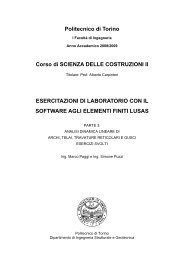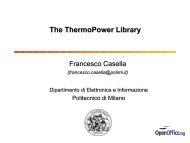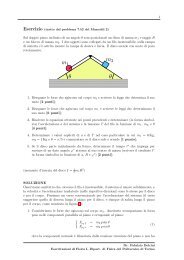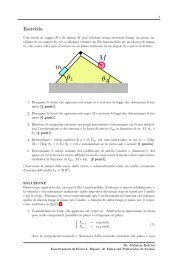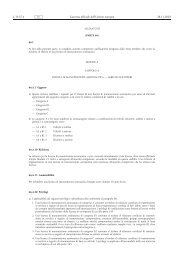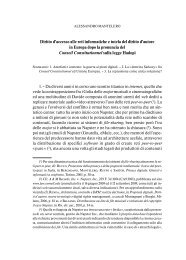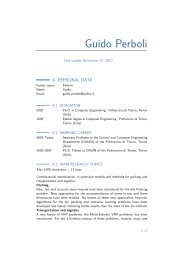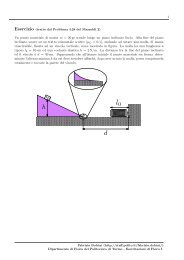The ITER toroidal field model coil project
The ITER toroidal field model coil project
The ITER toroidal field model coil project
Create successful ePaper yourself
Turn your PDF publications into a flip-book with our unique Google optimized e-Paper software.
204 A. Ulbricht et al. / Fusion Engineering and Design 73 (2005) 189–327<br />
bonded to the ground insulation of the <strong>coil</strong> so that the<br />
insulation was electrically tight in case of a vacuum<br />
breakdown and passing through the Paschen minimum<br />
pressure.<br />
3.7.2. Temperature sensors<br />
Three types of temperature sensors were used to<br />
monitor the temperature of the coolant of the <strong>coil</strong>,<br />
the case and the ICS. Due to the high magnetic <strong>field</strong><br />
the cheaper TVO sensors could not be used in certain<br />
positions. For measuring the helium temperature, 13<br />
CERNOX sensors (11 for the winding and 2 for the<br />
ICS) were placed directly in the helium flow inside<br />
the cooling pipes at the inlet and outlet points of the<br />
flow scheme. However, 31 TVO sensors were installed<br />
for monitoring and controlling the cool down process.<br />
<strong>The</strong>y were positioned on the surface of the <strong>coil</strong><br />
case, the surface of the ICS and on cooling pipes.<br />
Additional 4 Pt100 sensors were used to monitor the<br />
hot spots of the <strong>coil</strong> case and the ICS during cool<br />
down.<br />
3.7.3. Strain gauges, rosettes and displacement<br />
transducers<br />
<strong>The</strong> Lorentz forces deformed the overall and crosssectional<br />
shape of the <strong>coil</strong> case and the ICS. Thirtyfour<br />
individual strain gauges and 11 rosettes were<br />
installed to measure the surface strains at the main<br />
symmetry planes of TFMC, at the highly stressed<br />
wedges of the ICS and at the contact areas of TFMC,<br />
ICS and LCT. Twenty-four displacement transducers<br />
monitored the elongation of the joint area connecting<br />
adjacent double pancakes of the winding and<br />
the overall distortion of the shape of TFMC and the<br />
change of mutual position (details are presented in<br />
Section 8).<br />
3.7.4. Flow rate and pressure drop sensors<br />
<strong>The</strong> helium flow rate was measured by Venturi tube<br />
flowmeters Pancake DP1.1 and pancake DP1.2 were<br />
provided with individual Venturi flowmeters and pairs<br />
of capillaries for pressure drop measurements, because<br />
these were the pancakes foreseen for the heat slug injection<br />
to investigate the operation limits of the TFMC.<br />
<strong>The</strong>re were another six Venturi flowmeters installed at<br />
the inlet points of the remaining double pancakes and<br />
bus bars.<br />
3.7.5. Magnetic <strong>field</strong> sensors<br />
In the geometrical center of TFMC, a pair of Hall<br />
probes and pick-up <strong>coil</strong>s were installed to measure the<br />
magnetic <strong>field</strong> of the <strong>coil</strong>.<br />
3.7.6. Heaters at the inlet pipes of the DP’s 1.1<br />
and 1.2<br />
In order to make it possible to heat the helium flowing<br />
into the two pancakes adjacent to the LCT <strong>coil</strong> the<br />
corresponding inlet pipes were equipped with resistive<br />
heaters with a maximum power of 1000 W.<br />
3.8. Summary<br />
<strong>The</strong> specific manufacturing technology for the <strong>ITER</strong><br />
TF <strong>coil</strong> design was successfully developed by the construction<br />
of the <strong>ITER</strong> TFMC. <strong>The</strong> main effort was<br />
put in the fabrication of the radial plates and the specific<br />
manufacturing technologies related to heat treatment<br />
and the brittleness of the Nb3Sn conductor. <strong>The</strong><br />
milling of the groves as well as radial plate flatness<br />
within the small tolerances was a challenging task,<br />
which was solved. <strong>The</strong> “wind–react–insulate–transfer”<br />
method was the solution for handling the sensitive<br />
conductor without causing any degradation. Tolerance<br />
problems between the reacted conductor spiral<br />
and the groove of the radial plate were solved. All<br />
joints had to be fabricated with the reacted conductor.<br />
This was no problem with the applied joint technology.<br />
Soldering and EB welding techniques were<br />
used joining the special prepared conductor end of<br />
the pancakes with each other. <strong>The</strong> insulation system<br />
was based on fibreglass–Kapton tapes wrapping with<br />
a three step vacuum impregnation including the fixture<br />
of the winding pack in the thick-walled stainless<br />
steel <strong>coil</strong> case. <strong>The</strong> assembling of the TFMC<br />
with the inter-<strong>coil</strong> structure, which was manufactured<br />
by another company, was performed at the<br />
TOSKA site. <strong>The</strong> <strong>coil</strong> was equipped with an electrical,<br />
thermal-hydraulic, and mechanical instrumentation,<br />
which was integrated in the manufacturing steps<br />
of the TFMC.<br />
<strong>The</strong> whole manufacturing process was accompanied<br />
by quality assurance procedures guaranteeing the quality<br />
of the product in respect of its electrical, thermalhydraulics<br />
and mechanical properties.<br />
<strong>The</strong> manufacturing of the TFMC was a coordinated<br />
task under the leadership of EFDA between the indus-



